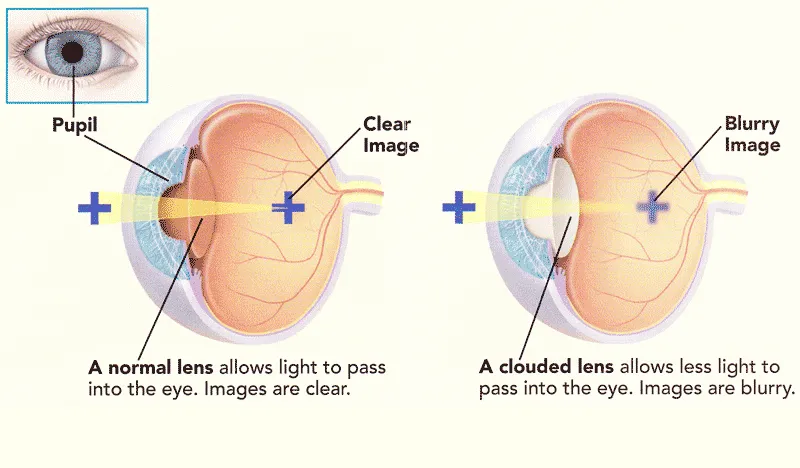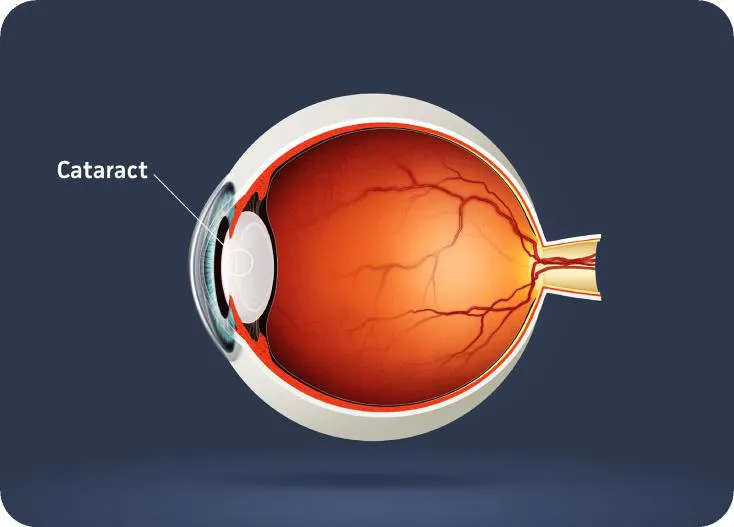Understanding Cataracts
Cataracts are one of the most common causes of vision loss…
but can they be corrected?
Cataract treatment Oklahoma has changed dramatically over the last 20 years, and for the first time, patients have access to a customized laser treatment for cataracts, making the experience better for patients and enhancing the accuracy.
Symptoms of a Cataract
Our eye functions much like a camera. The natural lens focuses images onto the back of the eye so we can see clearly, much like the lens of a camera focuses images onto film for a clear picture. At birth, our natural lens is clear, but as we age, it yellows, hardens, and may become cloudy. This condition is called a cataract and is usually a result of the natural aging process. As the lens becomes cloudier, vision becomes more blurred.
Symptoms that may indicate the presence of a cataract include:
- Gradual dulling of colors
- Halos around lights
- Glare when driving
- Difficulty reading in low light
- Blurred vision
- Frequent need to change your glasses prescription
A cataract can progress until, eventually, there is nearly complete loss of vision in your eye. Cataract surgery OKC is the only way a cataract can be removed and should be considered when cataracts cause enough loss of vision to interfere with your daily activities.

How My Physician Will Treat My Cataract
Surgery is performed in a fully-accredited outpatient surgery center. Patients need not expect to stay at the surgery center for more than a couple of hours. Prior to surgery, patients are given a relaxant to enhance calmness. Patients do not have to remain under anesthesia and should neither see nor feel any part of the surgery. Through a micro-incision, the cataract is dissolved and removed from the eye using ultrasound technology. The cataract is then replaced with a foldable lens implant through the original micro-incision. The incision is self-healing and heals without stitches.
Recovery Time: Since no eye patch is used, the eye can be used for vision immediately after surgery. Because the pupil will still be dilated after surgery, your eyesight may be somewhat blurry but will gradually improve over the next few days. After a short stay in the outpatient recovery area, you will be ready to go home. You are required to have someone drive you home, and you should plan to have a responsible adult remain with you for a few hours following surgery.
Cataract Surgery OKC for Patients with Both Glaucoma and Cataracts
iStent Trabecular Micro-Bypass stent is a new, FDA-approved surgical therapy that can significantly reduce eye pressure to help prevent vision loss. The iStent is placed in the eye during cataract surgery for the reduction of intraocular pressure (IOP) in adult patients with mild to moderate open-angle glaucoma.
MY LENS REPLACEMENT OPTIONS
There are many different types of intraocular lenses (IOLs) to choose from to correct cataracts. Lens replacement remains the most frequently performed and safest surgery in the U.S.
View Cataract Treatment Oklahoma Options
Multifocal and Accommodating IOLs are designed to eliminate your need or reduce your dependence on glasses after cataract surgery compared to the traditional monofocal IOLs. They are designed to provide both distance (far away) and near (close up) focus at all times.
Trifocal are designed to eliminate your need or reduce your dependence on glasses after cataract surgery compared to the traditional monofocal IOLs. They are designed to assist with a full range of vision, so that you can immerse in full range of activities – all while relying less on glasses. They provide near (up close), Intermediate (arm’s length), and distance (far away).

MONOFOCAL
MULTIFOCAL
A multifocal lens implant provides excellent vision after cataract surgery at a variety of distances. Multifocal lens implants correct both your distance vision and your near vision after cataract surgery. For the vast majority of patients, having a multifocal lens implant means that you will be able to see at a distance and up close without being dependent on glasses. Patients choosing to have a multifocal lens implant will likely find that they can drive, watch television, read, or do crafts without the need for glasses.
The Tecnis Multifocal® lens was designed to give patients back their youthful vision by correcting vision at any distance, and in any light condition — even in low light.
The first and only extended depth of focus lens, the TECNIS Symfony® IOL combines a unique diffractive pattern with achromatic technology to deliver outstanding visual acuity over a continuous range of distances while maintaining high image contrast.
As with any surgical procedure, there are associated risks and benefits. While virtually everyone experiences an improvement in vision after cataract surgery, some people will have better uncorrected vision than others.
Therefore, it is important to discuss the potential risks and benefits with your doctor. Good candidates for the Multifocal lens implant should have realistic goals for their vision and receive a complete evaluation by a BVA Ophthalmologist specializing in multifocal lens implantation.
ACCOMMODATIVE IOL
This type of lens is called an accommodating lens because it is flexible and able to change focus in response to the focusing muscles in our eyes, just as the natural lens does for people under the age of forty.
The Bausch & Lomb Crystalens® accommodating lens is designed to restore the eye’s accommodation ability, which is gradually reduced as presbyopia progresses. Like your natural lens, Crystalens works naturally with muscles in the eye to retain the eye’s ability to “accommodate” – shift focus between nearby and distant objects – after cataract surgery.
The Crystalens has the great advantage of allowing virtually all patients to see at both distance and intermediate distance without using glasses. In addition, most patients are able to read without glasses for all but the finest of print. In practice, the Crystalens is able to satisfy the visual needs of most patients for most of their daily activities without glasses. It is particularly good for driving, computers, cell phones, and newspaper-sized print.
Most patients with cataracts or who have had corneal refractive surgery and retained good eye health are acceptable candidates for Crystalens implantation, but those who have already had cataract surgery are not. Good candidates for the Crystalens should have realistic goals for their vision and receive a complete evaluation by a BVA physician.
TORIC IOL
For cataract patients with astigmatism, successful cataract surgery is only half the battle for regaining quality vision. BVA Advanced Eye Care offers the AcrySof Toric lens implant, a design proven to correct both your cataracts and astigmatism simultaneously. Implanted in the eye to restore distance vision after cataract surgery, the AcrySof Toric lens has a unique patented design that provides both spherical and astigmatic correction.
Beyond Traditional Cataract Surgery
CATALYS PRECISION LASER SYSTEM
In traditional cataract surgery, incisions in the cornea are made using handheld blades to access the cataract. However, the Catalys Precision Laser System offers tailored treatment to each individual’s eye. With Catalys cataract eye laser surgery OKC, your surgeon can make the incisions with exceptional precision and accuracy, creating a circular opening with the exact intended size, shape, and location using the precision of the laser.
During the cataract eye laser surgery OKC, the laser can also be used to break up and soften the hard cataract. Softening the lens with the Catalys laser enables your surgeon to then remove the cataract more gently and with significantly less ultrasound energy than is used in traditional manual cataract surgery.
ORA GUIDED CATARACT SURGERY
ORA (Optiwave Refractive Analysis) is a revolutionary new option used to gather data during cataract surgery to optimize postoperative visual outcomes. The ORA System assists the surgeon to select intraocular lenses (IOLs) that will match a patient’s precise needs regarding lens power, magnitude and axis of astigmatism, and aphakic and pseudophakic measurements. Whether the patient has had LASIK or has astigmatism, an ORA-guided cataract procedure provides the security of knowing they can have the best possible outcome and reduce the chance of needing an additional procedure.
Learn More about how ORA works, and Who is a candidate for ORA.
